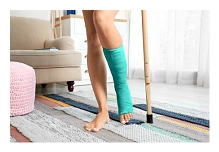 I am that person, the one who is thrilled the more challenging the wound looks. But I guess we all are, right? That is what has brought us together, this group of people who have never met, we are all connected through one simple thing, a passion for those hard to heal wounds. Unfortunately, we likely all have had those wounds that we have tried hard to heal and failed. That’s right, I have failed, we all have. I wish I was perfect; I wish I got it right from the start every time, but I don’t. It’s these really difficult wounds that help us grow as practitioners and I hope that as I share my mistakes with you, you don’t have to make them as well.
I am that person, the one who is thrilled the more challenging the wound looks. But I guess we all are, right? That is what has brought us together, this group of people who have never met, we are all connected through one simple thing, a passion for those hard to heal wounds. Unfortunately, we likely all have had those wounds that we have tried hard to heal and failed. That’s right, I have failed, we all have. I wish I was perfect; I wish I got it right from the start every time, but I don’t. It’s these really difficult wounds that help us grow as practitioners and I hope that as I share my mistakes with you, you don’t have to make them as well.
Let’s go back a few years. I am a new practitioner, excited to go into the wound care world and ready to fix everyone, or so I thought. I knew I would specialize, eventually, but I had my doctorate and I wasn’t going to wait to change the world. I noticed right away that I was having difficulty healing those pesky foot wounds. You know the ones—on the fifth metatarsal head or the tips of the toes. I was using the right dressings and I thought I was offloading appropriately, but I still couldn’t get them to heal. Skip ahead a few years, and I now realized I was forgetting a very important part of it all – understanding what was causing the wound in the first place. Perhaps they had decreased first toe extension, leading to a change in their pressure distribution; I would forget to address that, thus doing a disservice to my patient.
Now, when I treat a foot wound, the first thing I do is check their 1st digit extension and dorsiflexion mobility. It has significantly decreased the healing time for my patients. I look at the callus formations on their feet as this is an easy way to see where they are getting high pressure and shear. These calluses may not be the site of a current wound, but they are sites for potential wounds in the future. If I can change their mechanics to prevent further breakdown, of course, I am going to!
Let’s look at how these changes in mechanics change the pressure through our foot. With normal gait, we start with our heel strike, then roll through our foot, at which point we start dorsiflexing to about 15 degrees. At the end of the stance phase, our ankle starts to plantarflex, and our 1st toe must extend 60 degrees. When all of these components are working, we distribute pressure through the foot the way our body was designed to do; i.e. no wounds. The moment we remove or change a component of this pattern, we must compensate to complete the stance phase, thus changing our pressure distribution. For example, when a patient has limited dorsiflexion, they may roll through the outside of their foot rather than through the first toe at the end of the stance phase, leading to increased pressure at the fifth metatarsal head. Or maybe they compensate by externally rotating their hip; this is going to increase the pressure at the first metatarsal head. These changes are common with diabetic patients due to glycation of the ankle joint and thickening of the Achilles. When you combine increased pressure and repetitive stress, a wound is going to occur. If we do not address these orthopedic issues, we will have a difficult time healing the wounds and leave our patients at risk for developing the same wound again and again.
Once you have decided that your patient has decreased mobility, the next stage is treating it. The simplest way to increase mobility is to stretch the structures, but oftentimes this alone is not enough due to the soft tissues not being the only structures limiting motion. Despite this, I do give the patient some ownership of the issue by having them stretch at home. The best results for stretching would be a 90-second hold, 1-2 times per day, if the patient can tolerate it. Which stretch do I have them do? It depends on the patient and what they can do; I might have them do a standing gastric soleus stretch or one with a belt. If they have the mobility, I will have them manually stretch their toe into extension, if they don’t, I might recruit their caregiver to assist. As with any treatment, we must tailor it to our patients, their needs, and their abilities. Generally, I will also incorporate joint mobilizations and soft tissue work in the clinic to work towards improved mobility. I also give the patient strengthening for their foot intrinsic musculature, as deterioration often occurs in conjunction with the aforementioned issues. Unfortunately, these changes don’t happen overnight and you must have something in the interim for offloading. For me, Dr. Jill’s Offloading Felt has been a lifesaver, with my preference being the ½ inch felt. One side is adhesive, and you can stick it right to the foot so there is no need for the patient to adjust it or concerns of it shifting on the insensate foot. I cut out a piece the size and shape of the patient’s foot, as well as an additional cutout to offload the wound. There are a few downsides, you need to have good scissors and strong hands as the felt are not easy to cut. With an additional half-inch of material on the bottom of their foot, getting shoes on can be difficult as well.
There will be patients that we cannot get their mobility back for various reasons. I had one patient with a wound on his first metatarsal head who had a fused 1st toe and neurological damage that led to a very stiff ankle. With him, I enlisted the help of a prosthetist to help create a device that would offload the foot. Over time, the prosthetic created new pressures and new wounds, so we instead transitioned to a custom orthotic with a plastizote lining and cut-outs to offload the area. I have also seen numerous patients over the years who have a deformity that is no longer mobile; I see this frequently with claw toes. I am lucky enough to work in an orthopedic clinic with multiple surgeons who can assist me with these patients that may require a surgical cleanup of the joint, lengthening the Achilles, or techniques that may be outside of my scope.
Please don’t repeat my mistakes. Ensure that each patient who walks through the door with a foot wound has their foot mobility checked. You will see a change in the way you practice and how easily your wounds heal. Apply these principles, and you will be “a cut above” the rest.


